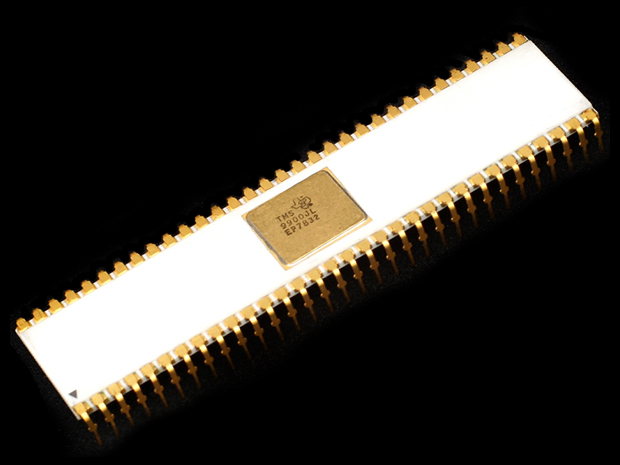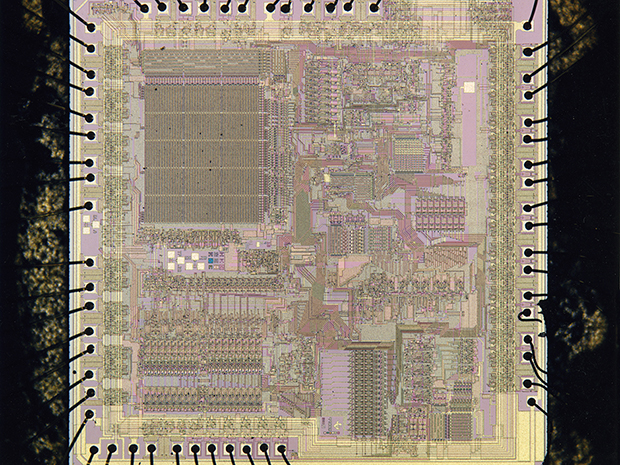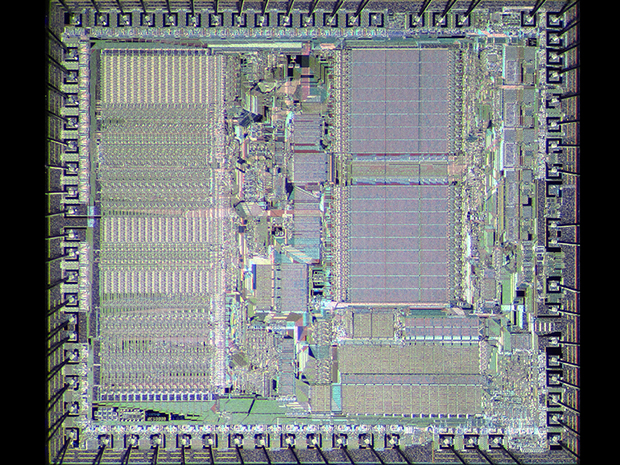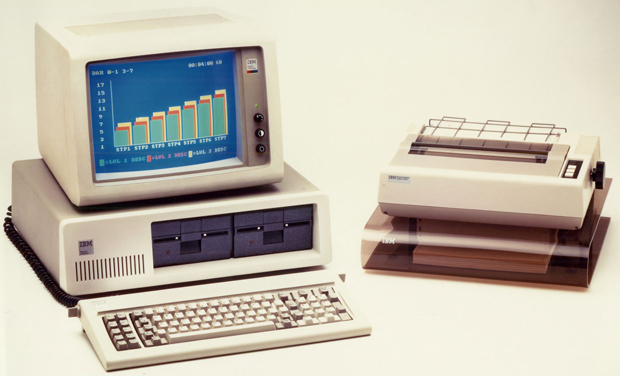The internal history of the largest error Texas Instruments, microprocessor TMS9900

If you are using a desktop or laptop computer, it probably has an Intel 808x line microprocessor, no matter if the machine is running Windows or Mac. The absolute dominance of these microprocessors dates back to 1978, when IBM chose 8088 for its first personal computer . But this choice was not at all obvious. Some believe that the Intel 8088 was the worst choice of 16-bit microprocessors available at the time.
No, it was not the worst choice. He was a serious, but worse, alternative. I know this because I was in charge of the organization that worked with TI, which developed it: TMS9900. Although this junk and used in the world's first 16-bit home computer , you probably have not heard of it. As they say, the history is written by the winners.
This chapter of the story is interesting not only for the TI chip, but also for its other competitor, Motorola 68000, which is technologically superior to both the Intel 8088 and TMS9900. And yet 68,000 did not make it to the IBM PC. And here's a little-known story from well-informed sources about how IBM chose an underdeveloped chip, TI spawned a loser, and the clear leader from Motorola lost.

In 1978, the author made a presentation of the TMS9900 chip, which was considered as a candidate for an IBM personal computer. TI did not get the contract.
I got a job at TI in 1972, right after graduate school, and two years later I gave a presentation for Jack Carsten , manager of the MOS department in Houston, where the company’s work on metal oxide semiconductor (MOS) chips was based. I, a young engineer, was somewhat timid in front of Jack, the entire presentation sat with his legs thrown on the table in the conference room, smoking a cigar and mumbling “garbage” every time he disagreed with something I was saying.
At that time, the big three semiconductor companies - Fairchild, Motorola, and TI - were trying to move from bipolar circuits to MOS. MOS chips required a completely different design and manufacturing process, and startups such as Intel developed much faster than existing companies. Of all the big three, TI succeeded best of all, thanks in large part to people like L.J. Sevin , who left TI in 1969 to establish Mostek and subsequently engage in venture capital investments. Karsten, who previously worked at TI as the general manager for the profitable product line of transistor-transistor logic (TTL), was also a key person in the transition to MOS.
The MI department at TI has achieved the most significant success in developing logic chips for the fast-growing market of portable calculators. Although the company competed, and eventually defeated Intel, in developing the first general-purpose processor, TI engineers were not particularly interested in Intel’s microprocessors (MP), 4-bit 4004 and 8-bit 8008. TI noticed 8-bit microprocessors 8080 and the one that followed 8080A, because they were more promising than 4004. The MOS department was ordered to catch up with Intel in both MP and DRAM (dynamic random access memory capable of cracking more memory cells onto the chip than RAM, but requiring constant updating to prevent data loss ).
So in TI, and there was a strategy for creating a general purpose MP. The key assumptions of the strategy were as follows: the application software will be the main incentive for the evolution of these chips, and as the owner of the successful MOS IC line, TI will be in an excellent position to develop an industry standard for microcomputers, security systems and consumer products. All listed industries were fast growing sources of profit for the company. But for this, TI had to jump over the current advanced 8-bit development, an example of which was the Intel 8080, and become the first company to bring a 16-bit architecture to the market. This strategy gave rise to a plan for the creation of the TMS9900.

Winner: Intel 8088 microprocessors were far from ideal, but IBM chose them for its personal computer, launched in 1981.
TI already demonstrated its computer skills in the supercomputer race in the late 1960s. This race was driven by oil companies that were trying to achieve a competitive advantage in 3D seismic analysis in the exploration of oil fields. TI was founded on this business. IBM, Control Data Corporation and other companies competed in this race, but TI was the first to market its Advanced Scientific Computer .
So for TI, the choice of architecture for a 16-bit chip was simple. TI had a “one company, one computer architecture” strategy aimed at using the synergistic effects that exist between different, incommensurable departments of the company. The Information Systems Division has already launched a TTL-based microcomputer family for use in the Ramada Inn hotel chain throughout the United States. So the TMS9900 was supposed to use an architecture very similar to the TI microcomputer architecture.
Carsten's team knew that the development of the TMS9900 - like its bipolar version for the military, called the SBP9900 - would take time, and the chips would most likely not be ready before 1975-1976. At this time, the MOS office needed to act. They planned to start by copying the Intel 8080A to bring anything to the market, then develop the original 8-bit microprocessor architecture (called the TMS5500), and finally go to the 16-bit TMS9900. National Semiconductor had already released a 16-bit general-purpose logic chip set called IMP-16 , but due to the fact that it was a set of several chips, it did not gain popularity.
The TMS9900 had its baggage of difficulties in development and delays, but in the end it was ready by 1976. Still, he ran into several major problems. First, there were no compatible 16-bit peripheral chips. And without peripheral chips, working on the transfer and storage of data, the MP will be useless for system development. The second problem was that the architecture of 9900, similar to the fact that TI used in microcomputers, had only 16 bits of logical address space - like the 8-bit processors of that time. This problem could not be solved without developing a new architecture from scratch. The last problem was that although TI could use the technology of one MP for its minicomputer, defense and semiconductor business, its competitors in these industries would be at a disadvantage if they began to take the architecture from TI for their products.

Loser: Among the major problems that plagued the TMS9900 was the lack of 16-bit peripheral chips, due to which the MP was useless in developing systems
To combat the lack of 16-bit peripherals, TI engineers came up with the following innovation. Why not adapt an 8-bit port on the TMS9900 so that a large number of already existing peripheral chips designed for 8-bit MPs can work with it? I am sure that at that time it seemed reasonable. As a result, in 1977 appeared TMS9980 . Attaching an 8-bit peripheral to a 16-bit MP eliminated the only real advantage of a 16-bit architecture: speed. 9980 required two command loops to execute a command from 8-bit peripherals, with the result that the effective speed dropped twice, which was no better than the already existing 8-bit MPs. Before the implementation of TI’s great plan, Karsten left the company for the position of vice president of sales and marketing at Intel, feeling beyond doubt that Intel would become a very serious contender who would be extremely difficult to beat in the MP market.
Intel naturally developed its own 16-bit microprocessor, 8086, which was released in April 1978. The company approached the issue of the lack of compatible 16-bit peripherals in exactly the same way, adding an 8-bit port to the MP, which gave rise to Intel 8088. Like TI 9980, Intel 8088 was junk, and showed reduced performance compared to 8086 in any real system. But Intel's chip had one fundamental advantage over TI: 20 bits of logical address space instead of 16. As a result, he had the ability to access a megabyte of memory, not 64K, like the TI 9900. In addition, the external registers TMS9900 and 9980 further worsened its speed.
And while Intel successfully developed alternative production sources for the 8086, TI struggled to make similar deals. At that time, most customers needed at least two competing vendors for each new family of semiconductor components to ensure product availability at an affordable price.
Meanwhile, several competitors announced their plans to create 16-bit general-purpose processors. The most ambitious plan was the Motorola 68000. Although it had 16 external contacts, its internal architecture was 32-bit, and it had 24 bits for a logical address space. The next product could possibly use 32 address bits. Zilog, the creator of the popular 8-bit MP Z80, announced the development of a 16-bit Z8000, with a segmented memory, the output of which was planned for 1978-1979. Unlike the 68000, the Z8000 had a simple 16-bit architecture.

Another competitor: The Motorola 16-bit MP 68000 had a 32-bit internal architecture, but it did not have time to go in time to become one of the possible options for the IBM PC.
In October 1978, six months after the announcement of the Intel 8086, I moved to the MOS office at TI and became the manager of the MP. By that time, everyone in the company, and many outside it, knew that TI’s 16-bit strategy for the MP did not work. The failure of the unit to develop a compatible 16-bit microcontroller TMS9940, which, to my appearance, had already passed 5 or 6 iterations, only exacerbated this problem. I knew that I was having a difficult situation. So why did I give up a good job as a manager of a consumer product development department? Location, location, location. The microprocessor business was located in Houston, and TI moved consumer products to Lubbock, Texas . Lubbock is a city in which the correct answer to the question “How do you like it here?” Would be “The people here are wonderful.” Country singer Mack Davis, who grew up here, once wrote a song with the chorus "I thought happiness was Lubbock, Texas in the rearview mirror."
Shortly after I arrived in Houston, I was told that I would have to make a presentation on the TMS9900 for a group from IBM that was working on a very secret project that required a 16-bit microprocessor. The group came from an unusual place for IBM: Boca Raton, Florida. I have been preparing for this for a very long time, gave, as I thought, a well-prepared presentation, and worked diligently with the consequences. But the IBM team showed little enthusiasm. Until 1981, we did not know what we lost.
John Opel , president, and later IBM CEO, made a revolutionary move by establishing a branch in Boca Raton, later known as the Entry Systems Division. He realized that Apple's personal computers, Commodore, Radio Shack, TI, and others could threaten IBM's dominance in the computer business. So he gave the group from Boca Raton, led by Philip Estridge , a blank check for the development of their product - an IBM personal computer. They could use the help of third parties for anything, including the development of operating systems and application programs. This attitude made the system quite “open” according to IBM standards, and accelerated the product’s entry into the market. However, Opel had one limitation: the product would be named IBM, so it cannot undermine the company's reputation for quality and reliability. Therefore, a massive organization for quality control within IBM had to sign the release of this product before the start of its sales.

Instant success: IBM 5150 PC was released in August 1981. In the US, a monitor, a printer and two drives did not come in the price of $ 1,565.
I didn’t have to argue about the choice of the IBM 16-bit MP team. The Motorola 68K, as it was called later, was without a doubt a clear favorite. It had the largest logical address space, which was even more important than the minimum 16-bit internal architecture. It was easy to expand to a fully 32-bit architecture. And, most importantly, the 68K worked with the “Big Endian” byte order, that is, from major to minor. We are talking about the order in which computers store bytes in memory. The 16-bit architecture came from the 8-bit one, and the engineers had to decide which of the 8-bit bytes would be the first in the 16-bit world. Digital Equipment Corp. chose low to high order (“Little Endian”) for its Programmed Data Processor (PDP) and VAX architectures. Intel did the same. But IBM computers used a different order, “Big Endian.” In order for “Big Endian” to communicate with “Little Endian”, the order of the bytes had to be changed backwards on the fly. At that time, such data conversion was not trivial. 68K from Motorola did not require conversion for use with the IBM PC. So why aren't we using 68K computers today?
The answer is related to who first entered the market. 8088 was imperfect, but at least it was ready, and 68K was not. IBM’s rigorous quality assessment process required the manufacturer to provide thousands of samples of the released product for each new part, so that IBM could conduct live tests on them. At IBM, hundreds of engineers were involved in quality control, but it takes time. In the first half of 1978, Intel already produced examples of 8088. By the end of 1978, 68K was not yet fully ready for release.
Unfortunately for Motorola, a group from Boca Raton wanted to launch a new IBM PC as soon as possible. So they only had two completely ready 16-bit MPs to choose from. In the competition of two non-ideal chips, the chip from Intel turned out to be less imperfect than the chip from TI.
The TMS9900 did not remain silently dying without receiving recognition from the IBM PC. The managers still hoped to push the corporate strategy. Of course, the TI home computer, which is still expected to be announced, will have to use the TMS9900?
The computer development team reluctantly agreed to give it a chance. This group was the result of an unfortunate merger of two departments, one of which was developing a game console, and the other - a personal computer. The resulting hybrid was not adapted for either one or the other. But TI stubbornly bent his line. TI-99/4 entered the market in 1979, followed by TI-99 / 4A in 1981. The company eventually sold 2.8 million units, most of them at a loss until it left the market in 1984 .
Meanwhile, the Intel 8086 architecture has evolved and overcome shortcomings. She still uses the Little Endian byte order, but today it doesn't matter. And Motorola, with its superior technology, lost the single most important development competition in the last 50 years.
Since we are talking about other competitors, I will say a few words about the OS for the IBM PC. The logical choice for the 16-bit OS was the expansion of the popular CP / M OS developed by Gary Kildall in Digital Research based on the Zilog Z80. The Boca Raton group understood that an open standard was behind CP / M, so they ordered Digital Research to develop a version called CP / M-86. In the process, Microsoft came up with the MS-DOS proposal, which has already been written about a lot. Therefore, the PC world was developing in the wrong direction, which could have been initially assumed, both in terms of operating systems and in terms of microprocessors.
What lessons can we learn from history? One - if you are developing a product based on a rapidly changing new technology, the main thing is to enter the market first, and it does not matter what limitations your initial product will have. Today in Silicon Valley, this approach is called creating a “minimally viable product.” If your product has new features that differentiate it from others, your customers will come up with innovative ways to use it.
The second lesson is that if you manage a large corporation that wants to create a project in a small, isolated from other department, not burdened by baggage or tradition, think about the restrictions imposed on it. It is likely that the restriction of the OS for the IBM PC would be more beneficial to the company in the long run than burdening the product with complex quality control procedures. No one could predict how much personalities will affect our lives, but the real value is not contained in the hardware, but in the compatibility of the OS. If IBM, not Microsoft, controlled MS-DOS, Windows and others, the world of computers would be completely different.
Finally, for people on the sidelines and just watching the high-tech parade, I’ll say: do not miss your opportunities. In the case of TI, in 1979 we decided that the TMS9900 had lost the general purpose MP race, and began to look forward to the future that comes after the general purpose MP. Our strategy focused on narrow specialization MPs and led to the development of the TMS320 , a digital signal processor. His announcement was made at the international conference on solid-state circuits in February 1982, and it was released the following year.The 320 DSP family and its derivatives began to bring almost half of all TI profits, prepared a new generation of company executives, and allowed TI to participate in the race of embedded processor systems on a chip. In the 1990s, this strategy reversed the declining trend among the best semiconductor companies and brought billions of dollars in chip sales to modems, drive controllers, and many other products.
All Articles